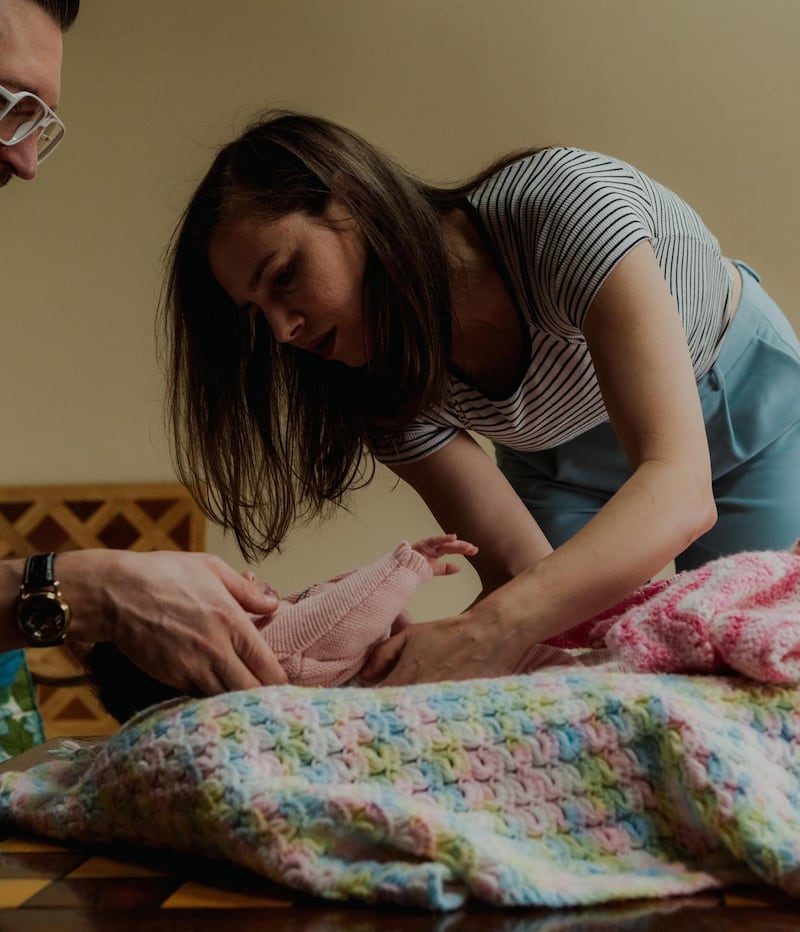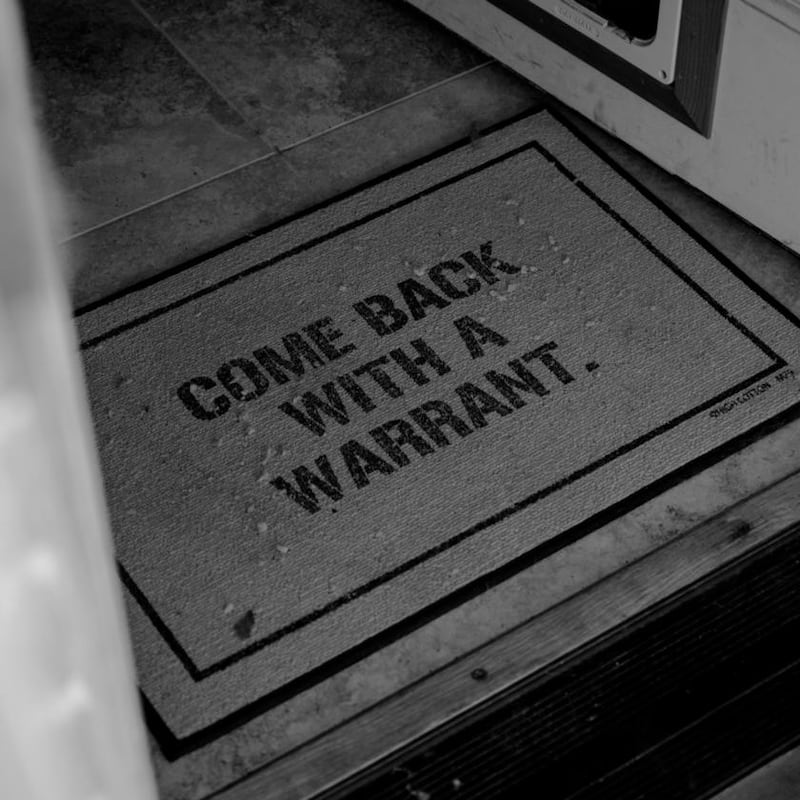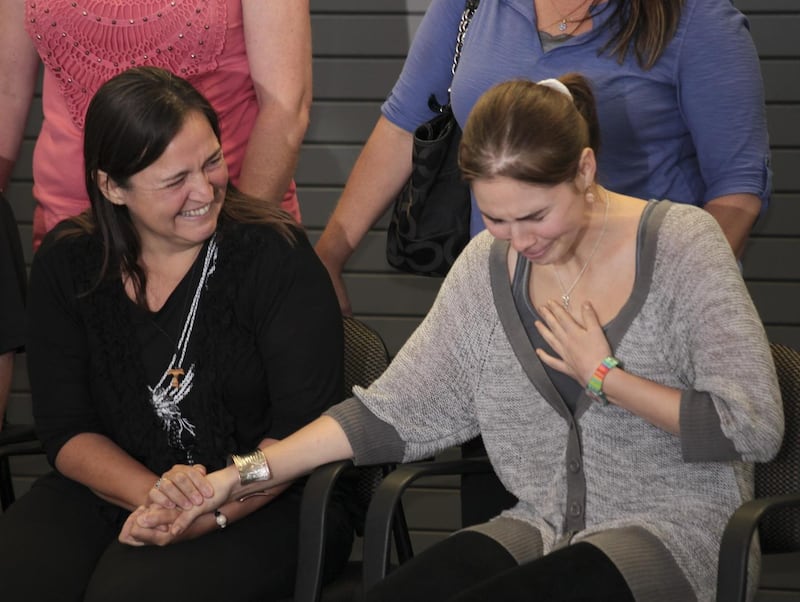Within minutes of meeting Amanda Knox for the first time, she plants her newborn daughter into my arms. Yes, Amanda Knox has a baby. A baby that she has been keeping a secret for months, worried that photographers would show up at her door, worried it would become a headline about "Foxy Knoxy's path to motherhood", which of course now it will.
I don't particularly want to hold the baby, whom Knox informs me is having trouble pooping, but here we are. "Ciao, amore," she cooes to her in Italian. The baby's name is Eureka Muse Knox-Robinson, and for the past few months, the 34-year-old and her husband, the novelist and poet Christopher Robinson, who is 39, have been documenting their pregnancy on their podcast, Labyrinths – but have not yet revealed that they're already parents.
Knox was the US student cemented in the public psyche as 'Foxy Knoxy' – jailed for four years, along with her Italian boyfriend of a week, for the rape and murder of her British room-mate, Meredith Kercher, while studying in Italy in 2007
"I'm still nervous about the paparazzi bounty on her head," Knox says, attaching a breast pump as we speak at the home she shares with her husband, daughter and three cats – Emil, Mr Fats and Pan – on Vashon Island, in Washington state. She is in orange plaid pants and a wrinkled button-down shirt, her hair in a high bun, looking like a new mom who has not slept in a while. "I will say I'm excited to not have to keep pretending not to be a mom. 'Cause it's, like, my brain is just there."
If documenting the most vulnerable details of a pregnancy on a podcast, then strategically rolling them out as a decoy strategy for the media, only to “reveal” your baby in a newspaper, all in an effort to control what’s being written about you, sounds like slightly convoluted logic, well, Knox has never been one to do the thing that people expect her to do.
You remember her story, right? Knox was the Seattle college student cemented in the public psyche as "Foxy Knoxy" – jailed for four years, along with her Italian boyfriend of a week, for the rape and murder of her British room-mate, Meredith Kercher, while studying in Italy in 2007.

Knox and her boyfriend, Raffaele Sollecito, were ultimately acquitted of that crime, with Europe's top human-rights court ruling that she had been deprived of adequate legal aid during an interrogation and that the DNA evidence used to convict her was flawed. It ordered Italy to pay her €18,400 in damages.
By then Rudy Guede, an acquaintance and known burglar who was convicted of the crime, had served eight years of a 16-year sentence. But most people don't remember that part of the story. What they likely do remember are the more salacious details of a Halloween murder in a picturesque medieval town: the prosecution's theory about a satanic sex game gone awry. A beautiful victim, Kercher, with an equally beautiful American room-mate, Knox, who behaved strangely in the days after the crime – doing "cartwheels" in the police station (they were yoga poses); shopping for "lingerie" with her boyfriend (she didn't have any clean underwear); and, later, showing up to court wearing a T-shirt that read, "All You Need Is Love", a line from her favourite Beatles song.
She was vilified as a sex-crazed, diabolical “luciferina” in court – and in the tabloids – and we would soon learn that Knox kept a vibrator in their shared bathroom and didn’t like to flush the toilet.
It is exactly 10 years since she was released from prison, yet Knox, who is now an advocate for the wrongfully convicted, is still trying to square the caricature of her murderous doppelganger with who she really is
It is exactly 10 years since Knox was released from prison, chased through the winding roads of Perugia to a safe house in Rome before boarding a flight home, its touchdown in Seattle covered live by the news. And yet Knox, who is now an advocate for the wrongfully convicted, is still trying to square that caricature of herself – her murderous doppelganger, as she calls her – with who she really is, what she is allowed to be and the way her daughter will see her. How much time should she spend trying to convince people of her innocence? To what extent is it okay for her to profit from the fame she never wanted?
Since coming home in 2011, Knox has waffled between periods of silence – trying to be invisible, she says – and aggressively trying to clear her name, first with a book about her experience and later as an advocate for others who were incarcerated for crimes they didn’t commit, most with far fewer resources or name recognition than she has.
For nearly four years Knox existed in a kind of legal purgatory, acquitted on appeal, and trying to live her life, but knowing she could be retried. That purgatory ended in 2015, when she was exonerated by Italy’s highest court.

In the meantime she had finished her undergraduate degree, in creative writing, at the University of Washington – before all this, she’d wanted to become a translator – and for a time worked in a used-book store, making minimum wage and writing columns under a pseudonym for a neighbourhood newspaper. “Getting a forward-facing, regular job was complicated by the fact that people would recognise me,” she says.
She spoke publicly about her experience in 2017 at a benefit in Seattle alongside Macklemore and Monica Lewinsky, and then again in 2019 at a conference in Italy – her first trip back – organised by the Italian Innocence Project, which didn't exist when she was on trial.
She has since hosted a true-crime podcast, appeared on Joe Rogan's podcast and published an essay in the Atlantic about the movie Stillwater, which, she argued, is profiting on her name and story. Knox has long had a complicated relationship with the media. And she has longed for her own "Monica moment", referring to the way Lewinsky has managed to rehabilitate her image.
But while her legal purgatory may be over, a kind of cultural purgatory remains. How do you move forward when the tiniest details of your life can spur a tabloid frenzy? How do you get a “regular” job when your name overshadows everything you do? How do you grapple with using that name – to build a life or an identity or a career – when there is a dead woman whose tragic story is dredged up every time you speak?
“That’s the sort of trap I’m in, where I’m constantly having to be in conversation with something that I would rather not,” Knox says. “I’m constantly told that I should just disappear.”

What happened that night in Perugia may be debated forever. But there are some basic facts – not rumours, not wild theories from the prosecution, not tabloid spin. The body of Meredith Kercher, a 21-year-old student at the University of Leeds, in northern England, was discovered in her bedroom in the house she shared with three room-mates, including Knox, on November 2nd, 2007. Guede – whose bloody fingerprints were found on the walls of the room, and his DNA on her clothes and inside her vagina – was tried separately from Knox and Sollecito and convicted before their trial began. He testified that he sat with Kercher as she died, didn’t call police and was still unable to get the river of blood out of his mind. “He must have talked about that blood for 10 minutes,” says
Nina Burleigh, an investigative journalist who covered the trial from Perugia. Guede was released last year.
It would later be determined that there was no biological trace of Knox or Sollecito in the bedroom, according to court documents. But after an all-night interrogation – in which Knox said she was hit in the back of the head by police and did not have a lawyer or interpreter present – Knox signed a confession, written in Italian, placing her at the house and accusing Patrick Lumumba, a Congolese bar owner who had been her boss, of the crime. Knox recanted within hours, and the confession was later ruled inadmissible in court, but Knox would be convicted of defaming Lumumba.

Any high-profile court case is as much a media battle as a legal one. In Italy, home of the paparazzi, juries are not sequestered, and it is common for police and lawyers to leak information to the press – which would help explain the leak of Knox’s jailhouse journal, which included a list of sexual partners, written after prison authorities told her she had tested positive for HIV. (She had not.)
“There were huge discrepancies between what was being reported in the media and what was in the actual police record,” says Burleigh, who is also the author of The Fatal Gift of Beauty: The Trials of Amanda Knox.
In Britain (as in Ireland), once a suspect has been charged, the law forbids journalists from speculating on their guilt or innocence until a verdict is reached, says Lieve Gies, a media scholar at the University of Leicester who studied the case. But because this crime played out in Italy, she says, that rule did not apply. “In terms of tabloid journalism, I don’t want to say it was a godsend, but it was a case that could be reported on without limits,” Gies says.
It's amazing to me how powerful that stampede of early tabloid coverage – a lot of it leaked straight from the prosecution – was to shape the narrative
Indeed, before police had even released Kercher’s last name, images from her Facebook page – including one of the last taken of her, dressed as a vampire for Halloween – were beamed around the world, Burleigh says. Reporters rummaged through the social-media profiles of Knox and Sollecito, lifting “Foxy Knoxy” – a soccer nickname going back to third grade, according to Knox’s best friend, Brett Lither – from Knox’s Myspace page, along with a photograph of her posing with an antique machine gun at a museum and one of Sollecito dressed up as a mummy, a butcher’s knife in his hand.
“To this day people are, like, ‘She’s guilty, right?’” says Jonathan Martin, the investigations editor at the Seattle Times, Knox’s hometown paper, who covered the story from Seattle. “It’s amazing to me how powerful that stampede of early tabloid coverage – a lot of it leaked straight from the prosecution – was to shape the narrative.”
Knox became a kind of “vessel” on to which society could project its fears and judgments as well as its pornographic fantasies, says Yvonne Jewkes, a criminology professor at the University of Bath, in southern England. Knox was perceived as an unsophisticated American, loud and flamboyant, ignorant of Italian culture. An exhibitionist and slob who brought strange men to the house. A sexual deviant who competed with her mother for attention, as the tabloids suggested. A Karen who had accused an innocent black man of the crime. All the while, Kercher was relegated to the background.

While in prison, Knox taught herself Italian by reading Harry Potter books and had imaginary conversations with her younger self, trying to comfort her. During holidays, her grandmother would light a candle in front of an empty chair in her honour.
But "home" wasn't the same home it had been when Knox returned – or, at least, she wasn't the same person. Tom Wright, a family friend, remembers a party hosted at Knox's aunt's house – with a "welcome home" cake baked by her grandmother – where Knox sat alone. "I said to her, 'Are you okay?' And she said, 'I just want the people not in this room to know I'm innocent.'"
In many ways, her community had rallied around her. An airline worker donated miles so her family could visit her in prison. An Italian professor at her college sent books so she could keep up with her studies. When she returned – paranoid and anxious – a family friend referred her to a member of Bill Gates’s security detail, who referred her to another guy, who set her up with free self-defence lessons.
She moved back into her childhood bedroom, where she immediately began purging: packing clothes, stuffed animals and pillows into garbage bags to give to charity. “I’d gotten used to not having so many things,” she says. “I felt totally overwhelmed.”

Her family encouraged her to take things slowly as offers to tell her story rolled in. But she was anxious to make up for lost time. “I felt like I was already behind by four years,” she says. She soon found an apartment with a friend, and then moved into a small house. She started dating a childhood friend, then rebounded with a man she met in a bar who’d lied about being wrongfully convicted and became threatening. “I felt like the most stupid person in the world, because, of all the people, I shouldn’t have trusted this person,” Knox says, beginning to cry.
She was working at the bookstore, taking walks at night to avoid cameras, and found solace in reading and playing guitar. She was still washing her underwear in the sink – a prison habit she couldn't seem to shake. "You know, we were in survival mode for a while," says her mother, Edda Mellas, a teacher. "At that point in time she really couldn't talk about it at all. She just cried."
Then, about a year after she returned home, Knox’s acquittal was overturned, and she was retried and reconvicted in absentia. She worried about extradition. Her family began looking into what it would take to hide her away in a bunker, telling her the less she knew, the better.
“I felt like I couldn’t even try to have a normal life, because I was carrying this shroud over me,” Knox says. “In part I was defiant. I felt like there was a deep injustice, so I didn’t change my name, I didn’t change my appearance. But I also felt defeated, like there was nothing I could do about it.”

By the time she was definitively acquitted, in 2015, Knox had been convicted, imprisoned, acquitted and released on an appeal, retried and convicted again, then ultimately exonerated by Italy’s supreme court. She and her mother were also tried and acquitted of slandering the Italian police. (In Italy it is a crime to insult or damage the reputation of public officials.) For the charges that she had defamed Lumumba, she was sentenced to three years, which she had already served.
Knox’s outlook changed after her exoneration. She met Robinson soon after, when she interviewed him about his novel, The War of the Encyclopeadists, for the West Seattle Herald, where she had only just begun using her real name.
Robinson decided not to Google her, he says, and let her reveal her story to him on her own. He has since become her staunchest defender. They don't have a PR representative, so Robinson is Knox's first line of defence, joining her on interviews, producing and editing their podcast and screening her social-media feeds for hate and death threats, while juggling his own writing career. And although the insults lodged at his wife are many, it is the accusation that there's something off about her that bothers him the most.
Every city has its version of “weird”, but Seattle – of the pre-Jeff Bezos era, anyway – was home to a particular flavour of counterculture. For those who know the place, it was no huge surprise that Knox, who had arrived in Perugia with all of her camping gear (tent, sleeping bag, stove) and a tea kettle in her suitcase was out of context in Italy.
But this grates at Robinson, who also grew up there. “There are a lot of people who will say, with good intentions, like, ‘I’m really sorry that happened to you. I’m a weird, quirky person, too.’ Or, ‘You should be allowed to be quirky. It doesn’t mean you’re a killer.’ And it’s, like, okay, but ... did you even think for a minute that your perception of her behaviour was mediated through a thousand other things?”
"I wasn't even that weird," Knox says, though she notes that she and her husband do like to go to Renaissance fairs (and her brother-in-law, Kyle Robinson, performs in a medieval-knights troupe). "Lots of people like going to Comic-Con; they're not all accused of murder," Robinson says.

While Knox was on trial in Italy, friends described her as naive, goofy, unconventional, harmless, trusting, sheltered, blunt and a little bit of a rebel. “She’s strong-willed, and that has even become more so,” her mother says. Knox describes herself as a something of a lifelong oversharer who, as a teenager, would ask the girls on the soccer team about their periods and told her mother the first time she smoked pot.
“She is porous with her boundaries,” says Taigé Lauren, a friend she studied poetry with at college. Indeed, there is an unfilteredness to Knox that some might find disarming. She is prone to break into song (her voice, for the record, is quite beautiful), is not shy to talk about bodily fluids, and will happily tell a reporter about the time she and her husband went to DomCon, a dominatrix convention, where she ended up stripping to her thong and being flogged in a hotel ballroom with other attendees. (It’s something of a miracle that story did not leak.)
"The misdirected focus on my sexuality was one of the things that bothered me most about the trials," Knox says in a podcast episode about the experience. "We started to wonder, what does a sex game gone right look like?"
Knox and Robinson live in a woodsy enclave a short ferry ride from west Seattle, where Knox grew up, but with enough distance from the mainland that they feel comfortable putting their name on the mailbox. “We have a little bubble, but we’re not completely off the grid,” Knox says. They go foraging for mushrooms in the woods behind their house. The mat on their front porch reads, “Come Back With a Warrant,” a gift from a public defenders’ conference where she spoke.
For most of the pandemic, and certainly since their daughter was born, they have hardly left this compound. They take turns going to town for groceries and take the occasional walk to their favourite lookout spot, where goats roam in a field and there’s a view of Puget Sound. Last month a couple of German photographers found their way to Knox’s grandparents’ house on the island, but for the most part they feel secure here.

On a recent weekday, while Robinson worked on a script for Labyrinths – their baby reveal episode – Knox recorded an interview with Maya Shankar, a cognitive neuroscientist who studies bias. Eureka, in a bassinet on the floor, stared at shapes in a book while Robinson rocked her with his foot. Above him was a shelf full of books about the Kercher case, including Knox’s own.
The advance for her 2013 memoir, Waiting to Be Heard, was reportedly $3.8 million, or about €3.3 million, which means people assume she got rich. But there’s only so far even that amount of money will go after eight years of legal bills and PR; three mortgages (her mother, father and grandmother took out second mortgages on their homes); a loan for her younger sister, Deanna, who had dropped out of college during the ordeal; and agent fees and taxes. Her father, Curt Knox, an accountant, says Amanda ended up with about $200,000, or about €170,000.
It was enough to help her start over. But with a podcast she and Robinson self-produce, a baby and 160 Patreon subscribers as their main source of income at the moment, they will need other work. And so they are hustling: pitching a film adaptation of her memoir, a TV project about exonerees, a new book for Knox. They plan to create a series of NFTs out of famous tabloid covers with Knox's face on them, and Robinson is working on a sci-fi novel and a nonfiction book about evolution, the future and psychedelics.
Another idea, for a documentary project, would explore Knox's relationship with her principal Italian prosecutor, Giuliano Mignini, a lifelong Perugian who during the trial portrayed Knox as a sex fiend looking to exact revenge on her room-mate and who argued that she had to have been involved in the killing because only a woman would cover a body with a bedsheet.
During her trip back to Italy, in 2019, she delivered a letter to him in Italian, asking if he might be willing to begin a dialogue. It took him a few months to respond, but they have been corresponding since then. She hopes to meet him in person one day and perhaps film the encounter.
Mignini, who has since retired and is publishing a book on the case next year, is open to the idea. Reached in Perugia, he says he has got to know Knox’s character in part through the chaplain at her former prison, a man named Don Saulo, with whom she became close, who was also the priest at Mignini’s childhood parish.
It's the paradox of being 'Amanda Knox', even so many years later: torn between wanting to live an anonymous existence... and wanting to control the narrative about her
“I am aware that finding herself far from home, at that age, she must certainly have suffered a lot,” Mignini says. While that perspective does not change his view of the case, he says, he acknowledges that she was portrayed “as a sort of Circe”, referring to the vilified witch from classic mythology, infamous for turning men into pigs.
Before Knox and Robinson’s wedding, in 2020, which was time-traveller-themed, they spent months working with a local artist to craft elaborate futuristic pods from which they emerged for their vows. They gave guests a book of poems they had written, called The Cardio Tesseract, which they describe as “an ongoing collision” between their hearts and minds. (The tesseract, Google tells me, is a four-dimensional analogue of the cube.)
“In an alternate life, we’d be sci-fi event planners,” Robinson says. Of course, they don’t have an alternate life. There is a frustration there, even a little bit of desperation.
It’s the paradox of being “Amanda Knox”, even so many years later: torn between wanting to live an anonymous existence – she fantasises about moving to a remote village in Germany and becoming a seamstress – and wanting to control the narrative about her; wary of the media that disparaged her but needing it to promote her professional endeavours; criticised for being so public about her life but unable to exist privately without the baggage that comes with her name.
"What I keep telling Chris is that I want to get to a place where I don't have to keep living the worst experience of my life so that we can pay the mortgage," Knox says. "I keep telling myself if all else fails, I can make cuckoo clocks for a living." – This article originally appeared in The New York Times




















